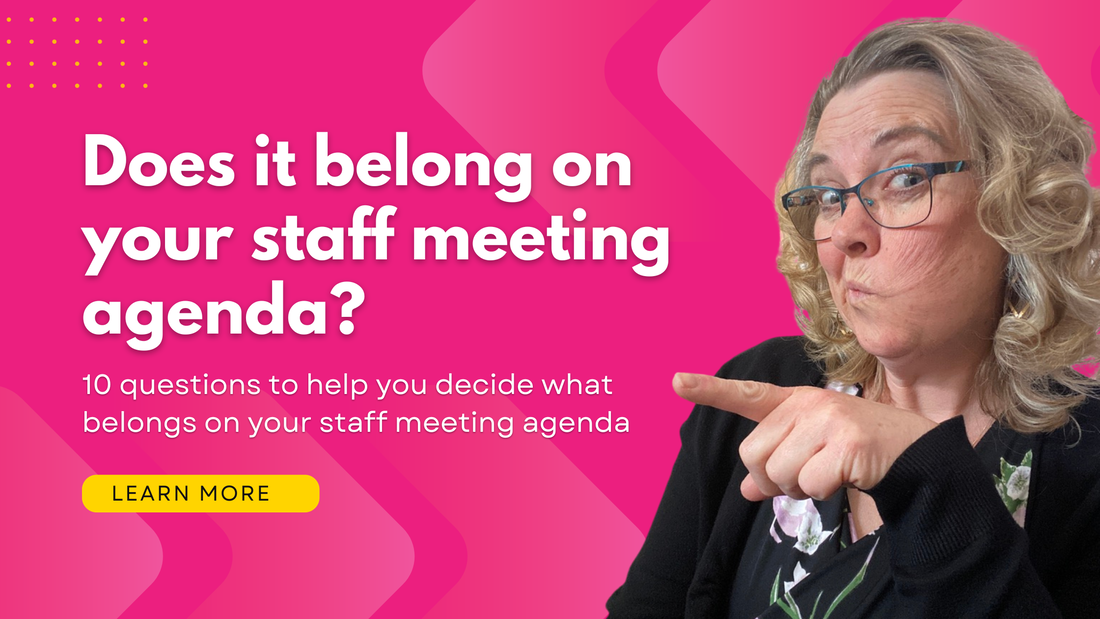|
We've all been to a nonprofit staff meeting where there are items that shouldn't be on the agenda. And often, it makes for a painful and long-drawn-out meeting. We wonder to ourselves or text our colleagues, "Why are we even talking about this?"
Often that's because nonprofit leaders haven't learned what belongs on a staff meeting agenda. Without training on how to run a staff meeting, we are left to follow what our predecessor did. If they did it for so many meetings, it must be the right way, no? Not necessarily. Learning what goes on your staff meeting agenda will help you feel more confident, competent and in control. Ask yourself these questions:
Let's start first with what's on your staff meeting agenda. Your staff meeting agenda should be prepared and provided to those who will be in attendance several days before the meeting. They need to know what to expect. Therefore, they may need to prepare. Additionally, if you are running an engaging and collaborative meeting, your team members may have items to add to the agenda. So what should go on a staff meeting agenda? Here are 10 questions you can ask yourself when you prepare for your next staff meeting Does this belong on your nonprofit team staff meeting agenda? 1) Does everyone need to know it and discuss it? If it is an item that only certain people need to discuss, either put it on a different meeting agenda or put it at the end of their agenda so that those people who the topic is not relevant for can leave early 2) Can it be done as an email update? If you were providing information, an email update might be fine. If you need a discussion around something, you may want to give the email update first so that people have time to prepare before the meeting. It's important to be clear on the agenda item what the agenda item is. It's not information sharing. Instead, the agenda item becomes
3) Is it the right time? Often we start talking about things before we have all the information, knowledge or information, and it can create anxieties, tension and confusion. Or we talk about things that aren't yet resolved, and really people shouldn't be privy to yet. Be cautious and trust your gut when you ask yourself, "Is it the right time to talk about this at this meeting?" Your intuition will know best. 4) What is the point of sharing it? Are you sharing information because it's something employees need to know, because it will help them somehow or because they need to prepare for it? If you can't figure out the point is for sharing it, don't share it. If you do know the point, be clear on what the point is. Please don't assume that everyone knows why you're sharing it. 5) Is everyone there that needs to be included to discuss this item? It's annoying to have a discussion that can't be resolved because the key stakeholder isn't at the meeting. When this happens, we often go around and around, but no one can make a decision or answer a question because the person with that power, authority or knowledge isn't at the meeting. Be sure the key players are at the meeting for that particular item if you put it on the agenda. 6) Do we have time for that discussion? Some discussions take time. When an agenda is crammed full, and we throw a topic in there and expect to brush over it, that often causes frustration for the people in attendance. They won't have time to explore, ask questions, provide suggestions and dig deeper. Brainstorming, for example, cannot be done well in three minutes. If an agenda item needs more time, create a separate meeting for it. 7) Is this the most efficient use of our time? Pulling a team together is costly and takes significant organizational time and resources. So make sure you're using that time and those resources wisely. 8) If this is a sensitive conversation, is it the right time to discuss it? Even though some topics are relevant for everyone, sometimes those conversations are difficult. It's not always the right time to discuss them. That may have to do with what's going on organizationally, in the world, or someone's family. Remember to be sensitive about the topic you put on your agenda. 9) Consider the urgency of the matter. Even though everything may be relevant to the agenda, that doesn't mean it needs to go on the agenda. If it's not an urgent topic and the agenda is already full, hold onto that topic for a future meeting. Give time and attention to the most pressing things, not just for you in the organization but also for your employees. 10) Is this the right place for this agenda item? Lastly, once you've decided that it does go on the agenda, be considerate of where you place it on the agenda. Things that need more discussion and focus should be done earlier on. Additionally, things that need more composure for a difficult conversation should be done earlier. You want to end on a positive, uplifting note. Therefore ensure the last item will make people feel good as they leave the meeting. Running an effective and engaging staff meeting is much easier when you are more conscious and intentional about creating your staff meeting agenda. DO THIS: 1) Schedule a few minutes into your calendar to prepare your agenda. 2) Consider what belongs on your agenda, running potential items through the above list of questions. 3) Feel confident, capable and in control as you run your next team meeting. Preparing is one of the first steps to feeling more confident running a staff meeting. When you prepare your staff meeting with intention, you will feel more confident, and your team will find it much more valuable and engaging.
0 Comments
Your comment will be posted after it is approved.
Leave a Reply. |

Available on Amazon
Archives
May 2024
|
|
Leadership TRAINING for Nonprofit Leaders
Become a confident and competent nonprofit Leader: Join The Training Library membership Executive and Leadership COACHING Leadership Coaching for Nonprofit Executives, Leaders and ManagerCoaching |
PODCAST for Nonprofit Leaders
The Surviving to Thriving podcast: Strategies, systems and support to lead your nonprofit with confidence FREE RESOURCES to Grow your Leadership Skills Free Leadership Training Resources, Worksheets and Templates |
Become a CONFIDENT LEADER
|




 RSS Feed
RSS Feed
